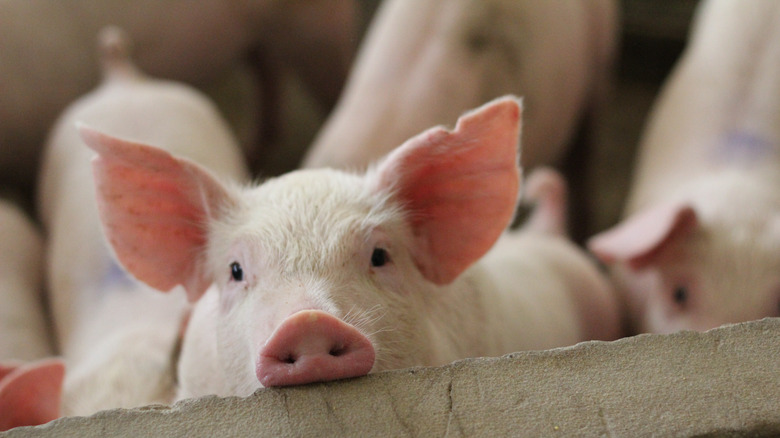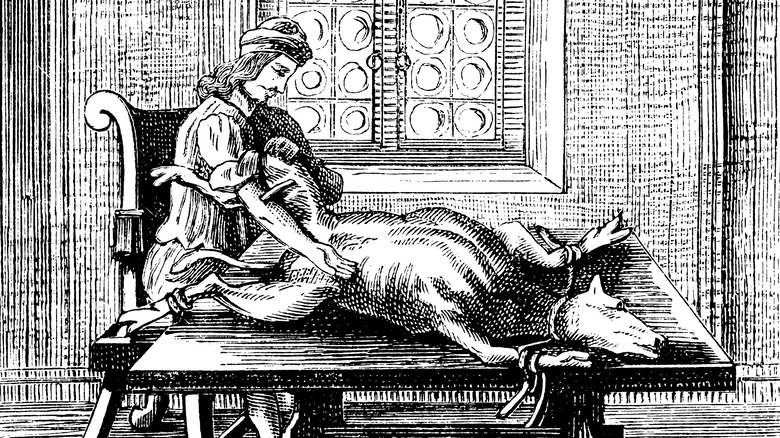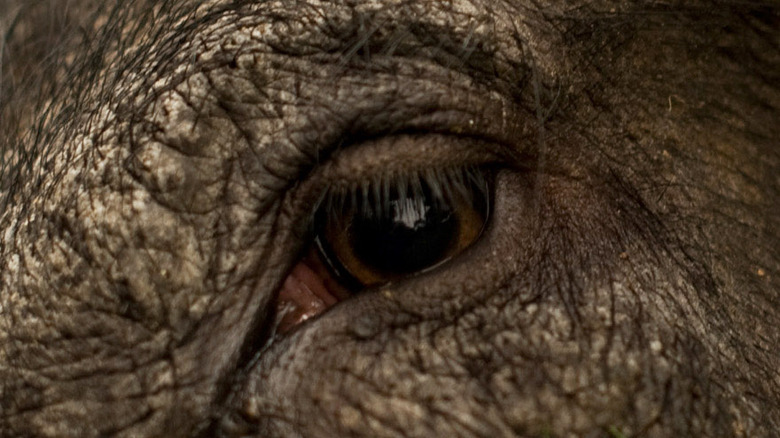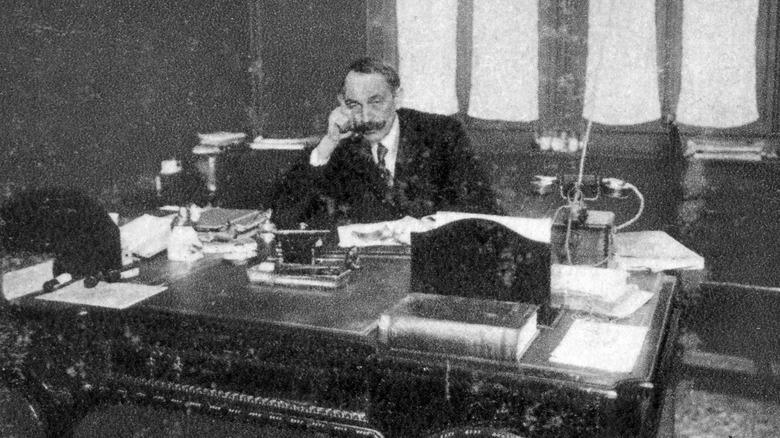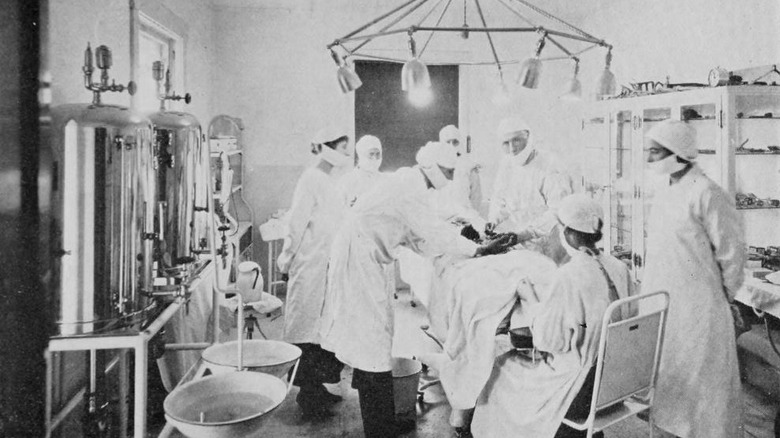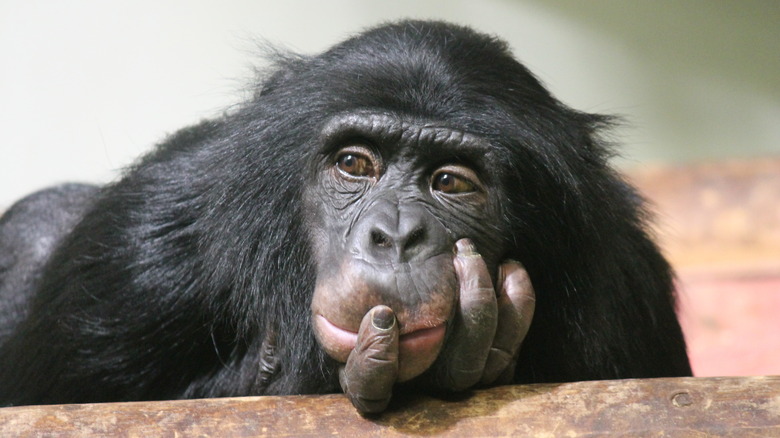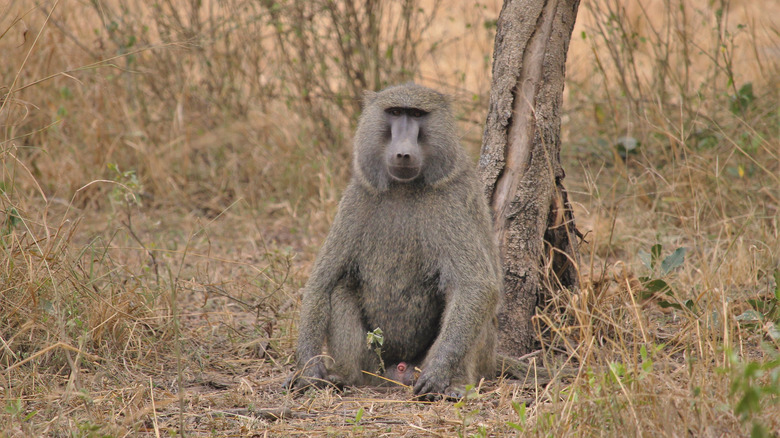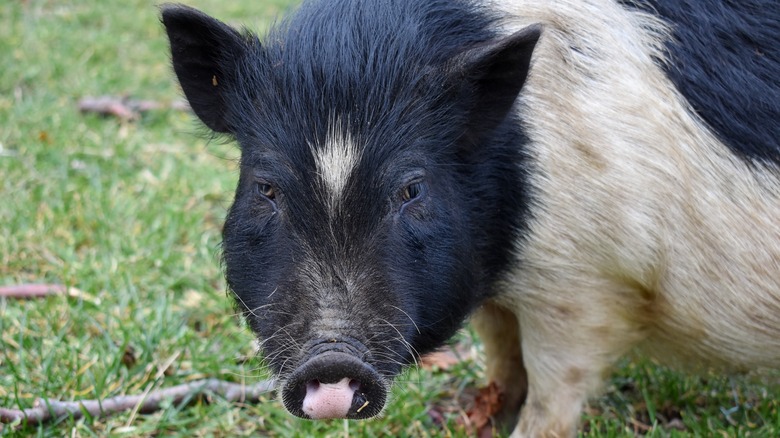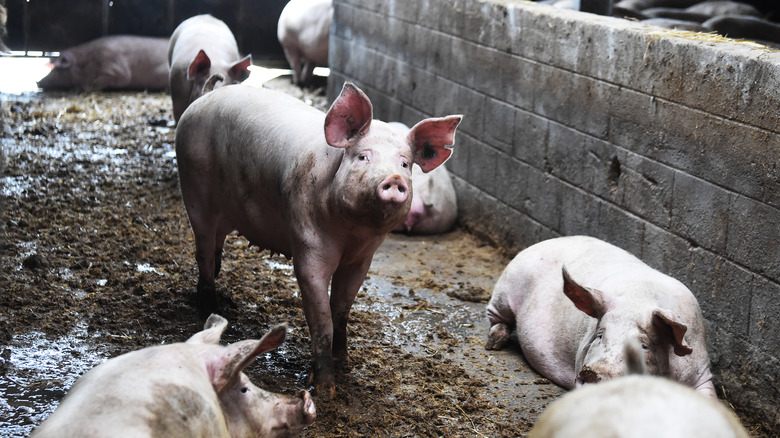The History Of Animal-To-Human Organ Transplants Explained
Humans have been attempting xenotransplants, also known as animal-to-human transplants, for hundreds of years with historically little success. Living bodies are complicated and it's hard enough to avoid Graft-versus-host disease within the same species, much less different genera. But that didn't stop scientists from trying. And although the idea of informed consent gets murky when the options are between an extremely experimental procedure and death (in most instances), a surprisingly large number of people participated in these types of experiments, leading us to the pig-to-human heart transplants of the 21st century.
With the expansion of genetic modification, scientists are able to modify animal organs to decrease the chance of rejection within the human host. But when did people start trying to patch up their bodies with the body parts of animals? While it may seem obvious to people nowadays, it took a surprisingly long time for some scientists to realize that animal body parts can't just be easily cut-and-pasted into a human. This is the history of animal-to-human organ transplants explained.
What is a xenotransplant?
Unlike an allotransplant, which involves the transplantation of tissue or organs between two members of the same species with different genotypes, a xenotransplant, also known as a heterologous transplant, involves transplantation from one species to another. This transplant, known as a xenograft, can involve anything from blood to entire organ systems.
According to the British Journal of Medical Practitioners, there are several ethical issues associated with xenotransplantation. Xenotransplants involve putting the well-being of a human above the well-being of an animal, which involves not only the death of the animal but the lifestyle it must be raised in to minimize "the risk of acquired infections." There's also the risk of animal-to-human disease transmission, known as zoonosis, which may lead to those with a xenotransplant being subjected to restrictions or temporary detentions. This brings up the question of whether or not someone would be able to give informed consent, "as it is difficult to be fully appreciative of future restrictions of one's liberty."
Xenotransplants are also considered to be especially difficult due to the high rate of transplant rejection. A pig's heart is thought to be one of the few exceptions to this, since it "can be treated so they do not cause such a strong immune response." But this knowledge wasn't intuitive. The development of xenotransplantation was full of lots of trials and just as many errors.
Bone transplants
One of the earliest recorded xenotransplants was by Persian surgeon Muhammad Baha' al-Dawla. Writing in "The Quintessence of Experience," published in 1501, al-Dawla described how he treated osteomyelitis in the skull by replacing the sick bone with a piece of bone from a dog. "A slice of cucumber was [also] used to protect the brain," according to Xenotransplantation. In the same text, Al-Dawla also described how in Herat, Afghanistan, Indian surgeon Ala-ul-Din used "fresh dog skin for a patient with eczema over the whole head."
In 1668, Dutchman Job Janszoon van Meekeren also wrote about the use of dog bone in xenotransplantation. It's unclear if van Meekeren was the one who performed the surgery on the Russian soldier or if he was merely recording the experiment of another doctor, but in "Bones and Cartilage," Brian K. Hall writes that the resulting procedure involved grafting bone from a dog onto a battle wound on a Russian soldier's skull.
The graft was reportedly a success, but when the Church learned about the graft they excommunicated the soldier. And although the soldier went back to the doctor to remove the graft "so that he could return to his church, the surgeon was unable to grant his request; the graft had taken too well."
Early blood transfusions
During the 1600s, humans tried to use literally anything as a blood transfusion. Popular Science notes that these substitutes included milk, urine, beer, and saline solutions. And considering that these were some of the options available, anyone who was getting transfusions of animal blood was comparatively getting the better end of the deal, short of actually having a human blood transfusion of the corresponding blood type.
One of the first xenotransfusions was done by French physician Jean-Baptiste Denis, who transfused lamb's blood into a 15-year old in 1667, Xenotransplantation writes. Although the patient survived, Smithsonian notes that it was likely because there was a "negligible" amount of blood used. Others, including Richard Lower, Matthäus Gottfried Purmann, and Georges Abraham Mercklin, also experimented with xenotransfusions. Often, the blood was either taken from a lamb or a calf, both of which have many more blood group systems than humans.
One incident involved Antoine Mauroy, a mentally-ill man in Paris. Denis believed that he could "cure" Mauroy by replacing his "bad blood" with "good blood," so he put up to six ounces of calf's blood in Mauroy. Although Mauroy reportedly survived the transfusions, "complain[ing] of heat running through his arm and strong pain in his kidneys," his subsequent death is believed to have been caused by arsenic poisoning.
Animal-to-human blood transfusions didn't last long in some European countries. In 1670, the French Parliament banned blood transfusions as did the English Parliament soon after.
Skin xenografts
Skin grafts using animal skin became "relatively popular" during the 19th century. However, the International Journal of Surgery notes that although some of these skin grafts were reported to have been a success, "it is almost certain that none of these grafts was in any way successful." Many different species were used, including sheep, rabbits, cats, pigeons, and frogs. Frog skin was considered to be "the ideal graft" and sometimes the frogs were "skinned alive" to get the skin necessary for the graft.
Ultimately, it's unlikely that any of these skin grafts were actually successful for the long term. Although they may have been used to cover a skin ulcer for a few days, it's unlikely that any of these early skin grafts were permanent. Medicina writes that the first successes wouldn't occur until the middle of the 20th century.
Nowadays, pig skin is sometimes used as a skin graft but even these are temporary, causing an immune reaction and rejection after about 14 days.
A pig's cornea
The 19th century also saw experimentation in corneal xenotransplantation. The first recorded corneal xenograft was performed in 1838 by New York ophthalmologist Richard Kissam on a "young Irishman" who was blind. According to the Oman Journal of Ophthalmology, the procedure involved cutting the cornea out of a 6-month-old pig and grafting it onto the human eye with two sutures, which were removed after 36 hours. Although there was reportedly "increased light perception," within two weeks the new cornea was clouded and within a month it had been "absorbed."
The Guardian writes in Scotland around 1875, Dr. J.R. Wolfe also claimed to have done a corneal xenograft. This time a rabbit was used, "cutting from a live rabbit the corresponding portion of the eye which the man had lost." Although Wolfe claimed that his xenotransplant was a success, with his patient returning to "fair sight," the editors of the Lancet were "very skeptical."
There were also up to five subsequent efforts to transplant an animal's entire eye into a human, mostly using the eyes of dogs, but out of those five attempts, the only one that was "initially successful" was the one that used a rabbit's eye.
Kidney slices
By the 20th century, some scientists had moved on to experimenting with different organ systems. One of the most notable examples is that of French surgeon M. Princeteau, who grafted slices of a rabbit's kidney into the kidney of a human child with poor kidney function in 1905. According to the ILAR Journal, Princeteau wrote that the "immediate results were excellent ... The volume of the urine increased; vomiting stopped." But unfortunately, 16 days after the surgery, the child died due to pulmonary congestion, also known as a buildup of fluid in the lungs.
The following year, two more renal xenografts were attempted by Mathieu Jaboulay, the Chief of Surgery in Lyon. This time, kidneys from a pig and a goat were used. "Neither graft functioned, and failure was attributed to vascular thromboses." Cold Spring Harbor Perspectives in Medicine writes that German surgeon Ernst Unger also attempted renal xenotransplants. After experimenting with kidney transplants in animals, Unger performed two renal xenografts using the kidneys of monkeys. However, none of these xenografts worked "for more than a few days, and all the patients soon died."
When New York doctor Harold Neuhof attempted a renal xenotransplant using the kidney of a lamb in 1923, the patient lived for nine days after the surgery until finally passing away. However, Neuhof was slightly encouraged, writing "[This case] proves, however, that a heterografted kidney in a human being does not necessarily become gangrenous."
Testicle rejuvenation
In the 1920s, Serge Voronoff, a Russian doctor working in France, became interested in helping older men who had lost their "zest for life." Hoping to create an anti-aging and rejuvenating effect, which translated into being able to have an erection, Voronoff started experimenting with monkey testicle xenotransplants. According to SPRING Journal, Voronoff performed the first xenotransplant of a monkey's testicle into a human on June 12, 1920, grafting sliced up pieces of the monkey gland into the scrotum. It's believed that Voronoff operated on up to 40 men in a private clinic during the 1920s and 1930s, but the practice soon spread. By the 1930s, "more than 500 men had been operated on in France, along with thousands of others all over the world — in the U.S.A., Italy, Russia, Brazil, Chile, and India."
Although it appears that a majority of people survived this xenotransplantation and that complications were reportedly uncommon, the International Journal of Surgery writes that "it is inconceivable that any of them had any beneficial effect whatsoever, except psychological." And in "Medical Blunders," Robert Youngson and Ian Schott also note that Voronoff's first two monkey xenografts had to be subsequently removed due to infections.
Voronoff also experimented with the xenotransplantation of the ovaries of monkeys into human women, believing that this could undo menopause. In "Contested Technologies," Anders Persson and Stellan Welin write that at one point, Voronoff also unsuccessfully experimented with transplanting human ovaries into a female chimpanzee and inseminating the chimpanzee with human sperm.
The 'goat gland doctor'
Many people were inspired by the xenotransplantation work that Serge Vornoff was doing, including an American man named John R. Brinkley, who fashioned his own version of this procedure. Becoming known as the "goat gland doctor," Brinkley became famous for his xenotransplants, which involved inserting "goat testicles into the scrotum of human males to increase their virility," writes The TMC Library. History Net writes that Brinkley got his diploma from the Eclectic Medical University of Kansas City, "which issued a diploma to anyone willing to pay $100," and settled down in Milford, Kansas. Brinkley reportedly came up with the idea for a goat testicle xenotransplant in the late 1910s after one of his patients "wished he was as randy as his billy goats." Before long, Brinkley was performing up to 50 surgeries a month at $750 each, which amounts to over $10,000 today.
It's unknown exactly how many people died because of Brinkley's xenotransplantation, but All That's Interesting notes that Brinkley signed at least 42 death certificates. And after the Kansas medical board revoked Brinkley's license to practice medicine, he moved to Del Rio, Texas, where he continued to perform goat testicle xenotransplants as well as "equally sketchy prostate surgeries."
Leo Stanley, the chief surgeon at San Quentin Prison, also experimented with putting the testicles of goats, boards, rams, or deers into hundreds of imprisoned people at San Quentin, who were also "exposed to tacit pressure to report favorably," per "Medical Blunders."
Chimpanzee-to-human
In the 1960s, more and more doctors began using the organs of chimpanzees for xenotransplantation. From 1963 to 1964, Keith Reemtsma, a surgeon at Tulane University in Louisiana, United States gave between six to 13 people chimpanzee renal xenotransplants. Although almost all of the transplants failed within eight weeks at the most, one of the patients lived for nine months until she suddenly collapsed and died. "It was suggested that she had died from an acute electrolyte disturbance," according to the Baylor University Medical Center Proceedings.
When Reemtsma was experimenting with the kidneys of chimpanzees, he was visited by surgeon James Hardy in 1963, who "was impressed by the health of some of the patients with chimpanzee kidney transplants." The following year, Hardy decided to attempt xenotransplantation with a chimpanzee heart. Boyd Rush, Hardy's patient, was "semicomatose" at the time of the transplant, but Hardy was determined to follow through with his endeavor and he went on to perform the xenotransplantation on January 24, 1964. Unfortunately, the heart failed within a few hours and Rush died without ever regaining consciousness.
Baby Fae
Stephanie Fae Beauclair, also known as Baby Fae, was born three weeks premature on October 14, 1984, with hypoplastic left heart syndrome. Fae's mother was told that the congenital anomaly was fatal and that the only options would be to take the baby home or keep her in the hospital, although there would be nothing more the hospital could do, according to The New York Times.
It was at this point that Baby Fae's mother was contacted by surgeon Leonard Bailey and asked her if she'd be willing to consider a baboon heart xenotransplant. Baby Fae's parents ultimately agreed to the experimental procedure and Bailey performed the transplant on October 26, 1984.
Although Baby Fae appeared to improve initially, her condition started to decline 14 days after the transplant due to "acute rejection." The International Journal of Surgery also notes that because the heart was "taken from a baboon that was ABO-incompatible with the recipient—as the O blood type is essentially not found in baboons—this might have added to the severity of rejection." Baby Fae died on November 16, 1984, living "more than two weeks longer than any previous recipient of an animal heart," per Time Magazine.
Baboon bone marrow
During the beginning of the HIV/AIDS epidemic, there was one theory regarding treatment that was "tantalizingly simple." Because baboons are "resistant to productive infection" with HIV-1, researchers at the University of California at San Francisco experimented with treating HIV/AIDS with a baboon bone-marrow transplant (BMT).
AIDS activist Jeff Getty received the BMT intravenously in 1995 and although the experiment had only "a slim possibility" of helping, Getty participated in the test because "there are few treatments open to late-stage AIDS sufferers like himself, and that he was putting his life on the line 'to try to get some answers,'" writes The Washington Post.
Ultimately, the experiment was considered to be a failure and the baboon bone marrow cells "quickly disappeared from his system." However, Getty's health did end up improving "significantly," although it's unclear if this was actually due to the BMT, or if it was due to the "radiation treatment and chemotherapy."
What happened to Purno Saikia?
In 1997, surgeons Dhani Ram Baruah and Jonathan Ho Kei-Shing performed one of the first pig heart xenotransplantations in Guwahati, India. According to The Wire, Baruah announced the successful transplant in January 1997, claiming that the procedure had been performed on a Purno Saikia, a 32-year-old terminally ill patient. But many didn't believe Baruah and claimed that it was all just an elaborate "hoax ... cheap publicity." And at one point even Baruah signed a statement that said he'd made the whole thing up. But then he alleged that the confession was forced out of him. "They threatened to shut down my hospital if I did not comply."
One week after the procedure, Saikia died due to multiple infections. And as a result, both Baruah and Ho were found guilty of "violating the human organ transplant laws in India," writes The Print, and imprisoned for 40 days. Although the xenotransplant was a failure, Baruah was determined to continue his xenotransplantation trials. However, he'd later claimed that his career in xenotransplantation "was totally disturbed due to the number of restrictions put by the court."
Genetically-modified pig organs
In the 21st century, xenotransplantation finally met up with genetic modification. In 2021, surgeons experimented with xenotransplantations involving kidneys from a line of genetically modified pigs. Nature writes that although the two patients who received the kidneys were "legally dead people with no discernible brain function," the transplants were considered to be a success because the organs weren't rejected and "functioned normally."
On January 7, 2022, David Bennett Sr. became the first person to receive a heart xenotransplant from a genetically modified pig, The New York Times reports. And as of the end of January 2022, Bennett's body doesn't appear to be rejecting the transplant.
Living with terminal heart disease, Bennett considered this experimental procedure to be his only option because he was ineligible for a human heart transplant, due to his history of being "medically noncompliant," which means that he didn't follow the recommendations of his doctors. However, Business Insider notes that whether or not someone should be disqualified from the transplant list because they didn't listen to their doctor's recommendations is a "thorn[y] question."

